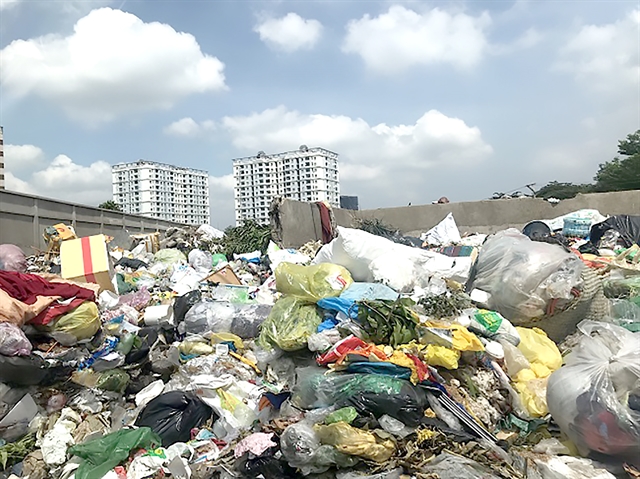
|
| People participate in a waste collection and classification festival in Huế City. — VNA/VNS Photo Mai Huyền Trang |
HÀ NỘI — Việt Nam is undergoing strong development with an increasingly rapid urbanisation rate, however, along with that is increasing population and increasing solid waste, putting great pressure on environmental protection.
A recent report from the Ministry of Natural Resources and Environment (MONRE) shows that in the 2016-21 period, the amount of domestic solid waste has been up nationwide.
The rate in urban areas increases by an average of 10-16 per cent each year.
At present, the country discharges about 60,000 tons of household waste every day, of which urban waste accounts for about 60 per cent.
Two big cities Hà Nội and HCM City eliminate 7,000-9,000 tons of household waste every day.
In recent times, many localities have actively built programmes and projects on waste classification at source.
However, this work has not been highly effective because waste classification programmes in most localities are not synchronised, implemented or formalised.
Many provinces and cities do not have separate equipment or means of collection for each type of classified waste.
In a lot of places, waste had been classified but then is transported together in the same equipment and vehicles.
In other places, waste treatment facilities only apply a general treatment method to different kinds of waste, so the effectiveness of separation at source is not high.
Because it is not classified, all types of waste are mixed together, so up to 71 per cent of the waste must be landfilled.
This creates huge pressure on the limited landfill facilities in localities.
Việt Nam now has about 400 domestic solid waste incinerators and over 900 landfills, including many unsanitary landfills.
Environmental experts say that if waste is simply buried, it will take up a large land area, push up landfill operating costs, and increase the risk of environmental pollution.
Recyclable materials are also buried, which will take hundreds of years to decompose.
Dương Thị Thanh Xuyến, Deputy Head of the Domestic Solid Waste Management Division, Department of Environmental Pollution Control under the MONRE, emphasised that waste classification at its source would promote recycling, extend the life cycle of products, and raise public awareness of environmental protection.
In particular, classifying waste at source will minimise the amount of waste that must be treated, thereby minimising costs for collection, transport and treatment.
Small action – great effect
Some localities are clearly aware of the role and significance of waste classification at source.
They have implemented specific solutions for effective waste classification at households.
With the goal of becoming a green city in Việt Nam, Huế City in Thừa Thiên-Huế central province has strived to change people’s awareness and practices about environmental protection.
It formed the habit of classifying waste at source for local residents.
Since last year, with sponsorship from waste classification projects and non-profit organisations, hundreds of sets of trash bins were installed in residential areas and public places.
People are guided and trained on proper waste classification.
Mai Thị Hồng Phúc, living in Phú Thượng Ward, Huế City, said that her family started classifying waste at source very early, not waiting until the city required it.
She shared the classifying method with many members of the Phú Mậu Commune Women’s Union.
Phủ Lý City in Hà Nam northern province generates over 100 tons of household waste every day.
The city piloted a model of waste separation at source with more than 87 per cent of households implementing it.
Organic waste is processed as animal feed and composted into fertiliser.
Recyclable waste such as newspapers, milk cartons and bottles are collected and sold to scrap collection facilities.
The remaining waste is collected and transported to the waste treatment plant.
Trịnh Minh Đức, Head of the Phủ Lý City’s Division of Natural Resources and Environment, said that the division gave instructions to locals, gradually changing their awareness.
Waste separation has reduced the city’s waste output by about 50 per cent.
Experience from practice

|
| Rubbish is not classified in HCM City. — VNA/VNS Photo Hoàng Tuyết |
In Huế City, some wards and communes have been equipped with green bins to store recyclable waste, but other types of solid waste still do not have appropriate containers.
Nguyễn Vũ Chánh Nghĩa, Deputy Head of the Planning Division under the Huế Urban Environment and Construction Joint Stock Company, said it was necessary to have different designs suitable for each group of waste.
Provinces and cities should also choose treatment methods appropriate to local socio-economic conditions.
Hà Nam Province does not have a facility to process biological fertiliser from waste. It is still treated by burning after classification.
Xuyến said that the situation was due to inadequate infrastructure from classification to collection, transport and treatment.
The classification work has been implemented in small-scale pilot areas with financial support from projects, making it difficult to replicate locally.
The pilot period is not long enough for people to change their habits of classifying household waste.
Clear policies
To make waste go through the correct cycle and bring benefits, a standardised operation is necessary.
Waste classification, collection and treatment must be carried out synchronously.
On January 10 last year, the MONRE issued Circular 02/2022/TT-BTNMT detailing a number of articles in the Law on Environmental Protection 2020.
The circular stipulates technical requirements on environmental protection for collection points, transfer stations, transport vehicles and criteria for domestic solid waste treatment technology.
Concerned units need to clearly stipulate tools, time and routes for waste collection, transport and treatment.
They must arrange gathering points, transfer stations and transport vehicles to meet technical requirements.
They should also allocate land fund for domestic solid waste treatment, as well as invest in innovating technology to ensure environmental and economic requirements.
One of the new points of the Law on Environmental Protection 2020 is giving proactive powers to local people’s committees in waste management.
Localities will develop their roadmaps suitable to actual conditions and supervise their implementation.
Another new point in the law is that for the first time, classification principles for household solid waste are regulated. Solid waste is divided into the group that can be reused and recycled, the group of food waste and the group of other solid waste. — VNS
- Reduce Hair Loss with PURA D’OR Gold Label Shampoo
- Castor Oil Has Made a “Huge” Difference With Hair and Brow Growth
- Excessive hair loss in men: Signs of illness that cannot be subjective
- Dịch Vụ SEO Website ở Los Angeles, CA: đưa trang web doanh nghiệp bạn lên top Google
- Nails Salon Sierra Madre
 VnExpress News The News Gateway of Vietnam
VnExpress News The News Gateway of Vietnam





